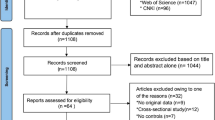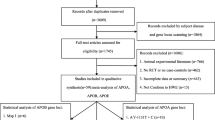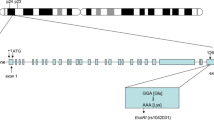Abstract
The associations of levels of apolipoprotein A1 (ApoA1) and apolipoprotein B and ApoB/A1 ratio and risk of a first stroke have not been reliably documented. We performed a meta-analysis to summarize the relationships and confirmed them in a case–control study. We identified relevant publications in PubMed and Embase databases up to June 1, 2015. A Dersimonian-Laird random effects model was used to compute summary relative risks (RRs) and 95 % confidence intervals (CIs). A case–control study was conducted in a southern Chinese population. We included 8 cohort and 4 case–control studies (222,774 subjects; 10,032 first stroke events) in the meta-analysis. Reduced ApoA1 level and increased ApoB level and ApoB/A1 ratio was associated with a first stroke in cohort studies (RR 0.86 [95 % CI 0.79–0.94], 1.66 [1.62–1.69], and 1.66 [1.63–1.70], respectively) and reduced ApoA1 level and increased ApoB/A1 ratio in case–control studies (0.68 [0.47–0.99] and 1.76 [1.50–2.06], respectively). When stratified by stroke type in cohort studies, the RR for ischemic stroke was 0.83 (0.76–0.90), 1.36 (1.32–1.40), and 1.38 (1.35–1.42) for the 3 factors, respectively. In our case–control study (1013 cases; 1029 controls), the OR for a first ischemic stroke was 0.83 (0.74–0.92), 1.33 (1.18–1.48) and 2.10 (1.76–2.51), respectively, with increased ApoA1 level associated with hemorrhagic stroke (1.37 [1.06–1.78]). Meta-analysis suggests that reduced ApoA1 level and increased ApoB level and ApoB/A1 ratio are risk factors for a first ischemic but not hemorrhagic stroke. Elevated ApoA1 level may be a risk factor for a first hemorrhagic stroke.






Similar content being viewed by others
References
Rader DJ, Hoeg JM, Brewer HB Jr (1994) Quantitation of plasma apolipoproteins in the primary and secondary prevention of coronary artery disease. Ann Intern Med 120(12):1012–1025
Walldius G, Jungner I (2004) Apolipoprotein B and apolipoprotein A-I: risk indicators of coronary heart disease and targets for lipid-modifying therapy. J Intern Med 255(2):188–205
Walldius G, Jungner I (2005) Rationale for using apolipoprotein B and apolipoprotein AI as indicators of cardiac risk and as targets for lipid-lowering therapy. Eur Heart J 26(3):210–212
Walldius G, Jungner I, Holme I, Aastveit AH, Kolar W, Steiner E (2001) High apolipoprotein B, low apolipoprotein A-I, and improvement in the prediction of fatal myocardial infarction (AMORIS study): a prospective study. Lancet 358(9298):2026–2033
Yusuf S, Hawken S, Ounpuu S, Dans T, Avezum A, Lanas F et al (2004) Effect of potentially modifiable risk factors associated with myocardial infarction in 52 countries (the INTERHEART study): case–control study. Lancet 364(9438):937–952
Walldius G, Jungner I (2006) The apoB/apoA-I ratio: a strong, new risk factor for cardiovascular disease and a target for lipid-lowering therapy--a review of the evidence. J Intern Med 259(5):493–519
Walldius G, Aastveit AH, Jungner I (2006) Stroke mortality and the apoB/apoA-I ratio: results of the AMORIS prospective study. J Intern Med 259(3):259–266
Bhatia M, Howard SC, Clark TG, Neale R, Qizilbash N, Murphy MFG et al (2006) Apolipoproteins as predictors of ischaemic stroke in patients with a previous transient ischaemic attack. Cerebrovasc Dis 21(5–6):323–328
Qureshi AI, Giles WH, Croft JB, Guterman LR, Hopkins LN (2002) Apolipoproteins A-1 and B and the likelihood of non-fatal stroke and myocardial infarction -- data from The Third National Health and Nutrition Examination Survey. Med Sci Monit 8(5):CR311–316
Chien KL, Sung FC, Hsu HC, Su TC, Lin RS, Lee YT (2002) Apolipoprotein A-I and B and stroke events in a community-based cohort in Taiwan: Report of the Chin-Shan community cardiovascular study. Stroke 33(1):39–44
Sharobeem KM, Patel JV, Ritch AE, Lip GY, Gill PS, Hughes EA (2007) Elevated lipoprotein (a) and apolipoprotein B to AI ratio in south Asian patients with ischaemic stroke. Int J Clin Pract 61(11):1824–1828
Koren-Morag N, Goldbourt U, Graff E, Tanne D (2008) Apolipoproteins B and AI and the risk of ischemic cerebrovascular events in patients with pre-existing atherothrombotic disease. J Neurol Sci 270(1–2):82–87
Hankey GJ (2006) Potential new risk factors for ischemic stroke: what is their potential? Stroke 37(8):2181–2188
O’Donnell MJ, Denis X, Liu L, Zhang H, Chin SL, Rao-Melacini P et al (2010) Risk factors for ischaemic and intracerebral haemorrhagic stroke in 22 countries (the INTERSTROKE study): A case–control study. Lancet 376(9735):112–123
Holme I, Aastveit AH, Hammar N, Jungner I, Walldius G (2009) Relationships between lipoprotein components and risk of ischaemic and haemorrhagic stroke in the Apolipoprotein Mortality RISk study (AMORIS). J Intern Med 265(2):275–287
Woo J, Lau E, Lam CW, Kay R, Teoh R, Wong HY et al (1991) Hypertension, lipoprotein(a), and apolipoprotein A-I as risk factors for stroke in the Chinese. Stroke 22(2):203–208
Christopher R, Kailasanatha KM, Nagaraja D, Tripathi M (1996) Case–control study of serum lipoprotein(a) and apolipoproteins A-I and B in stroke in the young. Acta Neurol Scand 94(2):127–130
Danesh J, Collins R, Appleby P, Peto R (1998) Association of fibrinogen, C-reactive protein, albumin, or leukocyte count with coronary heart disease: meta-analyses of prospective studies. JAMA 279(18):1477–1482
Higgins JP, Thompson SG, Deeks JJ, Altman DG (2003) Measuring inconsistency in meta-analyses. BMJ 327(7414):557–560
Egger M, Davey Smith G, Schneider M, Minder C (1997) Bias in meta-analysis detected by a simple, graphical test. BMJ 315(7109):629–634
Sabino AP, De Oliveira SM, Lima LM, Ribeiro DD, Dusse LMS, Carvalho MDG et al (2008) ApoB/ApoA-I ratio in young patients with ischemic cerebral stroke or peripheral arterial disease. Transl Res 152(3):113–118
Di Angelantonio E, Sarwar N, Perry P, Kaptoge S, Ray KK, Thompson A et al (2009) Major lipids, apolipoproteins, and risk of vascular disease. JAMA 302(18):1993–2000
McQueen MJ, Hawken S, Wang X, Ounpuu S, Sniderman A, Probstfield J et al (2008) Lipids, lipoproteins, and apolipoproteins as risk markers of myocardial infarction in 52 countries (the INTERHEART study): a case–control study. Lancet 372(9634):224–233
Shahar E, Chambless LE, Rosamond WD, Boland LL, Ballantyne CM, McGovern PG et al (2003) Plasma lipid profile and incident ischemic stroke: the Atherosclerosis Risk in Communities (ARIC) study. Stroke 34(3):623–631
Benn M, Nordestgaard BG, Jensen GB, Tybjaerg-Hansen A (2007) Improving prediction of ischemic cardiovascular disease in the general population using apolipoprotein B: The Copenhagen City Heart Study. Arterioscler Thromb Vasc 27(3):661–670
Canoui-Poitrine F, Luc G, Bard JM, Ferrieres J, Yarnell J, Arveiler D et al (2010) Relative contribution of lipids and apolipoproteins to incident coronary heart disease and ischemic stroke: The PRIME Study. Cerebrovasc Dis 30(3):252–259
Mora S, Buring JE, Ridker PM, Cui Y (2011) Association of high-density lipoprotein cholesterol with incident cardiovascular events in women, by low-density lipoprotein cholesterol and apolipoprotein B100 levels: a cohort study. Ann Intern Med 155(11):742–750
Schmidt C, Bergstrom G (2014) Apolipoprotein B/apolipoprotein A-I ratio and apolipoprotein B: long-term predictors of myocardial infarction in initially healthy middle-aged men-a 13-year follow-up. Angiology 65(10):901–905
Milionis HJ, Liberopoulos E, Goudevenos J, Bairaktari ET, Seferiadis K, Elisaf MS (2005) Risk factors for first-ever acute ischemic non-embolic stroke in elderly individuals. Int J Cardiol 99(2):269–275
Kostapanos MS, Christogiannis LG, Bika E, Bairaktari ET, Goudevenos JA, Elisaf MS et al (2010) Apolipoprotein B-to-A1 ratio as a predictor of acute ischemic nonembolic stroke in elderly subjects. J Stroke Cerebrovasc 19(6):497–502
Acknowledgments
This study was supported by the Science and Technology Plans of Guangdong Province (2013B021800264). We thank the staff envolved in this study in the communities of Shantou. We also thank Dr. Stanley Lin and Dr. Laura Smales for English language editing.
Compliance with ethical standards
ᅟ
Conflicts of interest
The authors declare that they have no conflict of interest.
Statement of human rights
The studies have been approved by the Second Affiliated Hospital of Shantou University Medical College and Chaonan Minsheng Hospital ethics committee and have been performed in accordance with the ethical standards as laid down in the 1964 Declaration of Helsinki and its later amendments or comparable ethical standards.
Informed consent
Informed consent was obtained from all individual participants included in the study.
Funding
This study was funded by the Science and Technology Plans of Guangdong Province (2013B021800264).
Ethical approval
All procedures performed in studies involving human participants were in accordance with the ethical standards of the Second Affiliated Hospital of Shantou University Medical College and Chaonan Minsheng Hospital and with the 1964 Helsinki declaration and its later amendments or comparable ethical standards.
Author information
Authors and Affiliations
Corresponding author
Additional information
Hongli Dong, Wei Chen and Xiangyu Wang contributed equally to this work.
Electronic supplementary material
Below is the link to the electronic supplementary material.
ESM 1
(DOC 58 kb)
Rights and permissions
About this article
Cite this article
Dong, H., Chen, W., Wang, X. et al. Apolipoprotein A1, B levels, and their ratio and the risk of a first stroke: a meta-analysis and case–control study. Metab Brain Dis 30, 1319–1330 (2015). https://doi.org/10.1007/s11011-015-9732-7
Received:
Accepted:
Published:
Issue Date:
DOI: https://doi.org/10.1007/s11011-015-9732-7




